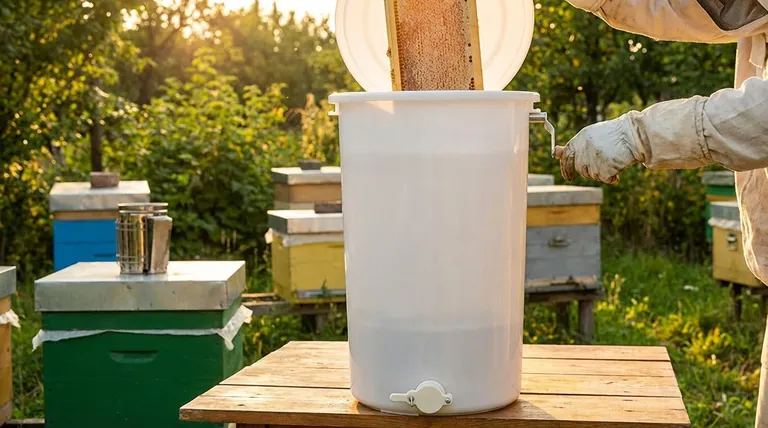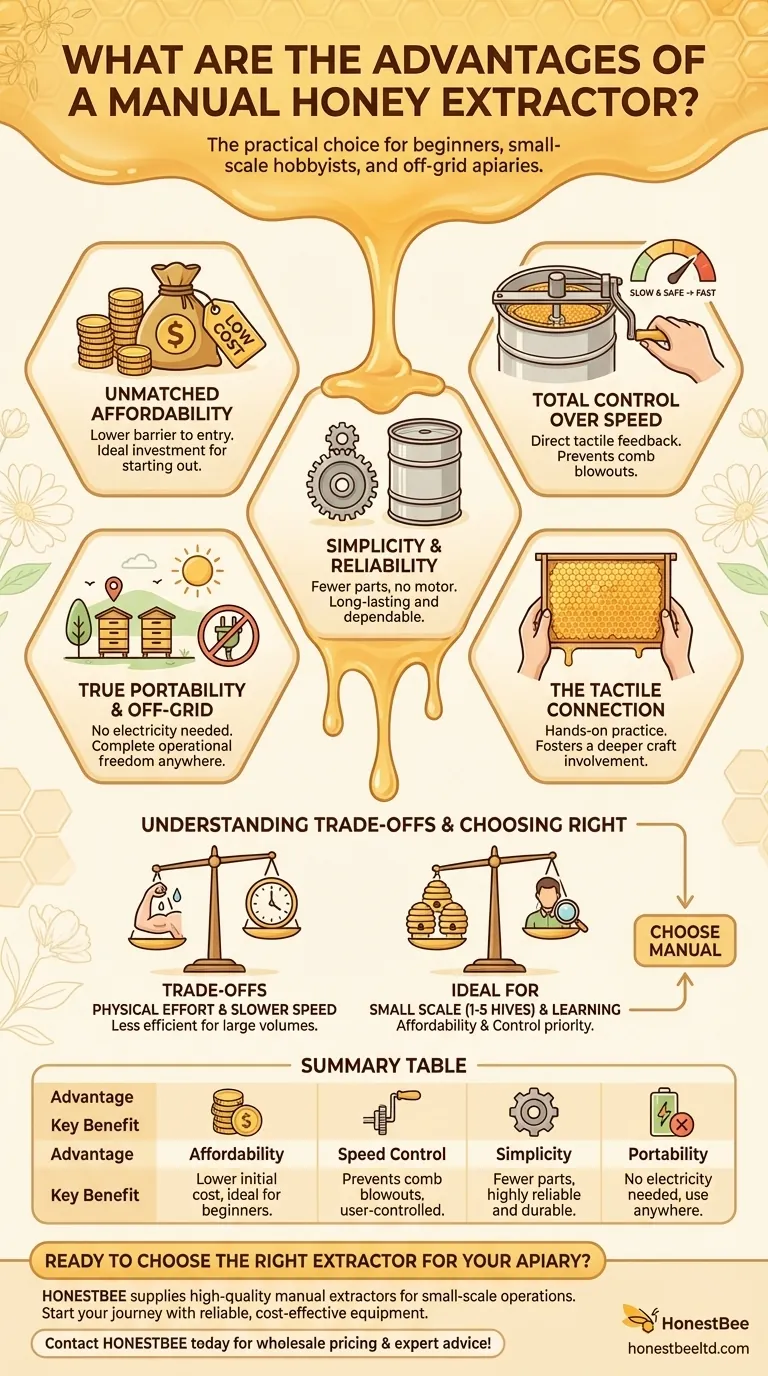The primary advantages of a manual honey extractor are its lower cost, greater control over extraction speed, operational simplicity, and independence from a power source. These factors make it an exceptionally practical tool for beginner beekeepers, hobbyists with a few hives, or anyone operating in a location without reliable electricity.
The decision between a manual and motorized extractor isn't about which is "better," but which is appropriate for your specific scale and goals. A manual extractor prioritizes affordability and hands-on control, making it the superior choice for small-scale beekeeping operations.

The Core Benefits of Manual Extraction
A manual extractor's design philosophy is rooted in simplicity and direct user control. This translates into several key advantages for the hobbyist or new beekeeper.
Unmatched Affordability
For those new to beekeeping, the initial equipment cost can be significant. Manual extractors offer a much lower barrier to entry compared to their motorized counterparts.
This cost-effectiveness allows you to invest in a crucial piece of equipment without a substantial financial commitment, making it the ideal starting point.
Total Control Over Extraction Speed
A manual extractor gives you direct, tactile feedback and complete control over the rotational speed via a hand crank.
This is critical for preventing "blowouts," where the centrifugal force destroys delicate new wax combs. You can start slowly to extract honey from the first side, then flip the frames and increase speed for the second, heavier side.
Simplicity and Reliability
The mechanics of a manual extractor are straightforward, consisting of a drum, a basket, and a crank-operated gear system.
This simple design means there are fewer points of failure. With no motor or electronics to break down, a well-maintained manual extractor is an incredibly reliable and long-lasting tool.
True Portability and Off-Grid Use
Because they require no electricity, manual extractors are inherently portable.
You can use them in a remote bee yard, a shed, or any location where a power outlet isn't available, offering complete operational freedom.
The Tactile Connection
For many hobbyists, beekeeping is a hands-on practice. A manual extractor enhances this connection.
The physical effort involved and the direct feel of the process are seen by many as a rewarding part of the harvest, fostering a deeper involvement in the craft.
Understanding the Trade-offs
While the benefits are clear, it's essential to understand the limitations of a manual extractor to make an informed decision.
The Demand of Physical Effort
The primary trade-off is the requirement of your own physical energy. Cranking the extractor, especially for multiple hives, can be tiring.
What begins as a rewarding experience with one or two hives can become laborious and time-consuming as your apiary grows.
The Limitation of Speed and Efficiency
Manual extraction is inherently slower than using a motorized unit. The process of cranking, stopping, and flipping frames takes more time and attention.
This makes it less efficient for beekeepers who need to process a large volume of honey quickly. A manual extractor can become a significant bottleneck in a larger operation.
Choosing the Right Extractor for Your Apiary
Your choice should be guided by a realistic assessment of your current needs and future ambitions as a beekeeper.
- If your primary focus is affordability and learning the craft: A manual extractor is the ideal starting point, offering essential functionality without a large investment.
- If your primary focus is a small number of hives (typically 1-5): The hands-on control and cost-effectiveness of a manual model perfectly match your scale.
- If you anticipate rapid growth or value time savings above all: You should strongly consider a motorized extractor, as the manual effort will quickly become a limitation.
- If you operate in a location without reliable power: A manual extractor is your most practical and reliable choice, providing complete independence.
Ultimately, selecting the right extractor is about matching the tool to the scale and philosophy of your beekeeping journey.
Summary Table:
| Advantage | Key Benefit |
|---|---|
| Affordability | Lower initial cost, ideal for beginners |
| Speed Control | Prevents comb blowouts, user-controlled |
| Simplicity | Fewer parts, highly reliable and durable |
| Portability | No electricity needed, use anywhere |
Ready to Choose the Right Extractor for Your Apiary?
For beginner beekeepers, hobbyists, and equipment distributors, selecting the right tools is the first step to a successful harvest. HONESTBEE supplies high-quality, durable manual honey extractors and other essential beekeeping supplies designed for the needs of small-scale operations.
We help you start and grow your beekeeping journey with reliable, cost-effective equipment. Let's discuss your needs and find the perfect solution.
Contact HONESTBEE today for wholesale pricing and expert advice!
Visual Guide

Related Products
- Plastic Hand Crank 2 Frame Honey Extractor Low Price
- 6 Frame Manual Stainless Steel Honey Extractor Beekeeping Equipment
- 2 Frame Stainless Steel Manual Honey Spinner Extractor for Beekeeping
- HONESTBEE 3-Frame Manual Acrylic Honey Extractor
- Easy Use Manual Stainless Steel Honey Press for Honey Comb
People Also Ask
- What tips can maximize honey extraction efficiency? Unlock Higher Yields and Purer Honey
- What makes polyurethane foam environmentally friendly? The Surprising Benefits of a Durable, Inert Material
- What are the general precautions to take when extracting honey? Ensure a Safe, Efficient Harvest
- Can manual honey extractors effectively remove honey from cells? A Guide for Small-Scale Beekeepers
- What equipment is used for honey harvesting? Build Your Perfect Harvesting Toolkit



















